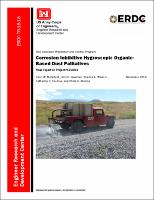Please use this identifier to cite or link to this item:
https://hdl.handle.net/11681/29970Full metadata record
| DC Field | Value | Language |
|---|---|---|
| dc.contributor.author | Morefield, Sean W. | - |
| dc.contributor.author | Newman, J. Kent | - |
| dc.contributor.author | Weiss, Charles Arthur, 1961- | - |
| dc.contributor.author | Thomas, Catherine C. | - |
| dc.contributor.author | Malone, P. G. | - |
| dc.date.accessioned | 2018-11-06T15:07:39Z | - |
| dc.date.available | 2018-11-06T15:07:39Z | - |
| dc.date.issued | 2018-11 | - |
| dc.identifier.govdoc | ERDC TR-18-18 | - |
| dc.identifier.uri | http://hdl.handle.net/11681/29970 | - |
| dc.identifier.uri | http://dx.doi.org/10.21079/11681/29970 | - |
| dc.description | Technical Report | - |
| dc.description.abstract | Dense airborne dust caused by military ground vehicles is a large, multi-faceted problem for the Department of Defense. One costly aspect of the problem is that fugitive dust and small rocks made airborne by ground vehicles on unpaved military service roads increases erosive damage to vehicle coatings. The dust palliative products most widely used to stabilize the surfaces of unpaved roads are formulated using corrosive salts such as magnesium chloride. These are effective at reducing erosive coating degradation but they negate that benefit due to their inherent corrosiveness of exposed metal on vehicle undercarriages. This report documents the testing, demonstration, and validation of several soil-binding materials that effectively suppress fugitive dust while being less corrosive than the most widely used dust palliatives. Based on laboratory and field test results, as well as data in the technical literature, a commercially available refined oil called Durasoil was found to be the most effective and least corrosive dust palliative of all materials and blends investigated. For purposes of calculating economic benefits, Durasoil was analyzed against magnesium chloride, which is the most widely used dust palliative. The projected return on investment of using Durasoil instead of magnesium chloride was 18.1. | en_US |
| dc.description.sponsorship | Department of Defense Corrosion Prevention and Control Program (U.S.) | en_US |
| dc.description.tableofcontents | Abstract .................................................................................................................................... ii Figures and Tables ................................................................................................................... v Preface ..................................................................................................................................... vi Unit Conversion Factors ........................................................................................................ vii 1 Introduction ...................................................................................................................... 1 1.1 Problem statement ............................................................................................ 1 1.2 Objectives ........................................................................................................... 2 1.3 Approach ............................................................................................................ 2 1.4 Metrics................................................................................................................ 3 2 Technical Investigation ................................................................................................... 4 2.1 Technology overview .......................................................................................... 4 2.2 Road design/build ............................................................................................. 4 2.3 Laboratory corrosion testing ............................................................................. 4 2.4 Laboratory dust-suppression testing ................................................................ 6 2.5 Field application of dust palliatives .................................................................. 6 3 Discussion ....................................................................................................................... 10 3.1 Results.............................................................................................................. 10 3.1.1 Laboratory corrosion testing .................................................................................... 10 3.1.2 Laboratory dust testing ............................................................................................. 12 3.1.3 Dust palliative performance field testing ................................................................. 12 3.2 Lessons learned ..............................................................................................15 4 Economic Summary ....................................................................................................... 16 4.1 Costs and assumptions ................................................................................... 16 4.1.1 Alternative 1 (baseline scenario) ............................................................................. 16 4.1.2 Alternative 2 (demonstrated technology) ................................................................ 16 4.2 Projected return on investment (ROI) ............................................................. 17 5 Conclusions and Recommendations ........................................................................... 19 5.1 Conclusions ......................................................................................................19 5.2 Recommendations ..........................................................................................19 5.2.1 Applicability ............................................................................................................... 19 5.2.2 Implementation ......................................................................................................... 19 5.2.3 Future work ............................................................................................................... 20 References ............................................................................................................................. 21 Appendix A: Supply Road Sub-Base Design ...................................................................... 25 Appendix B: Laboratory Corrosion Testing ........................................................................ 35 Report Documentation Page | - |
| dc.format.extent | 54 pages / 4.423 Mb | - |
| dc.format.medium | PDF/A | - |
| dc.language.iso | en_US | en_US |
| dc.publisher | Construction Engineering Research Laboratory (U.S.) | en_US |
| dc.publisher | Geotechnical and Structures Laboratory (U.S.) | en_US |
| dc.publisher | Engineer Research and Development Center (U.S.) | en_US |
| dc.relation.ispartofseries | Technical Report (Engineer Research and Development Center (U.S.)) ; no. ERDC TR-18-18 | - |
| dc.rights | Approved for Public Release; Distribution is Unlimited | - |
| dc.source | This Digital Resource was created in Microsoft Word and Adobe Acrobat | - |
| dc.subject | Dirt roads--Dust control | en_US |
| dc.subject | Gravel roads--Dust control | en_US |
| dc.subject | Soil stabilization | en_US |
| dc.subject | Vehicles, Military--Corrosion | en_US |
| dc.title | Corrosion inhibitive hygroscopic organic-based dust palliatives : final report on Project F12-AR11 | en_US |
| dc.type | Report | en_US |
| Appears in Collections: | Technical Report | |
Files in This Item:
| File | Description | Size | Format | |
|---|---|---|---|---|
| ERDC TR-18-18.pdf | 4.53 MB | Adobe PDF |  View/Open |